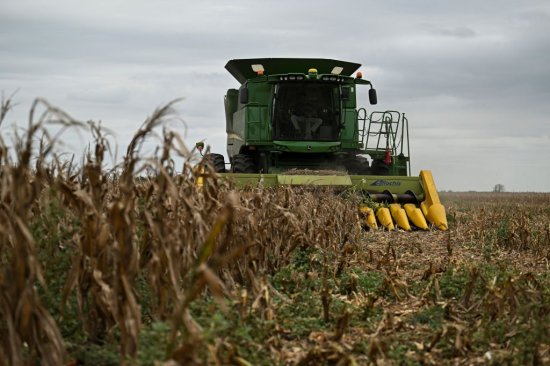
Food can be more climate resilient. But we have to work together, writes Himanshu Gupta.
In today’s climate-changing world, climate events thousands of miles away drive the cost of everything around us—from a flight ticket to a new piece of clothing to the market price of a meal at your favorite restaurant.
Take olive oil and chocolate as examples. Severe droughts in the Mediterranean have slashed Spain’s olive harvest by 40%, driving up prices by 27% in June compared to last year for American consumers. Similarly, the price of some chocolates, such as Cadbury’s Freddo, are already higher by 200% this year in Australia with similar price rise expected in the U.S markets, driven mostly by the extreme weather impacting small-holder cocoa farmers in Ghana and Ivory Coast.
[time-brightcove not-tgx=”true”]Such climate disasters in wheat producing countries such as Argentina also impact essential food products such as breakfast cereal, pasta, and bread. The price of wheat—and wheat-based food products—has experienced some of its greatest volatility in years since 2021. Why? Wheat production in Argentina was hit by drought in 2021and then in 2023, panicking global wheat supply chains already stressed by the Russia-Ukraine crisis. Food companies reacted to this volatility by preemptively increasing consumer prices.
Wheat price spikes might mean an extra dollar for pasta for me as an Indian American now living in California, but for my cousins back in India, food inflation means cuts elsewhere, like education budgets. Growing up in countryside India in a joint family of 14, we often faced these challenges. When food prices increased, my three siblings and I had to switch to buying second-hand textbooks at the start of the new school year. A similar pattern has been observed in low-income American households, too, who switch to canned fruits and vegetables from fresh ones in response to rising food prices.
Our planet is locked into several decades of climate change, regardless of our current mitigation actions. As an entrepreneur working to make food and agriculture supply chains more climate-resilient, I know we need to fundamentally rethink our approach to supply chains to ensure affordable, available food for all.
Read More: How to Feed the World Sustainably
Food supply chains are among the most critical in the world, and they face some of the biggest climate change-related threats, such as extreme weather, rising temperatures, and water scarcity impacting crop yield and quality—all of which affect food security. But while climate change contributes significantly to this problem, other events such as wars compound it. Consequently, many governments enter “panic mode” and enact protectionist measures to protect their interests. However, this often has domino effects that add to the exact problem they intend to avoid—price surges across food supply chains disproportionately impacting lower and middle-income consumers, including farmers who are net consumers themselves. Meaning, many farmers spend more money on food for their families than they make by farming crops.
In theory, policies such as nearshoring (relocating supply chains to neighboring countries such as Mexico), friendshoring (relocating supply chains to ally nations such as India) and “America First” are helpful for semiconductor supply chains. But they can’t work in food supply chains. Sriracha peppers can’t grow in Minneapolis, and avocados can’t grow in Canada. Even if countries succeed in diversifying their food supply chains with friendly nations, it doesn’t necessarily mean that supply chains on both sides won’t be impacted simultaneously by climate events .
Instead, we need a radical rethinking of our approach to building resilience in food supply chains. So far, all the approaches to climate adaptation are country or company-specific. But this global challenge requires a global solution: a collective, cooperative effort that is proactive rather than reactive from governments and companies on an international supply chain level to build resilience in the face of climate change.
One of those global initiatives could be to launch supply chain climate adaptation plans (S-CAPs). These plans, similar to national climate adaptation plans, would be led by multilateral organizations—WTO or World Bank in collaboration with governments—and private sector companies in food, agrochemical, and transportation sectors. They would start by identifying vulnerable global food supply chains, focusing on essential foods like wheat and rice. They would map out areas prone to climate risks, critical transport routes, and important farming regions. Then, they would develop strategies and identify projects to reduce these risks, such as creating climate-resistant seeds, diversifying transport methods, investing in technology to detect hazards, and growing crops in safer areas.
An effort like this would require funding—a combination of international funding and companies’ contributions to support assessments, R&D, and implementation. In fact, unlike initiatives for cutting carbon emissions, driven mainly by reputational and regulatory concerns, initiatives to protect our food supply chains could have 2 times to 10 times the return on investment in the short-to-medium term. For instance, Ethiopia’s investment in drought-resistant crops and water management increased yields by 40% and enhanced food security, returning $2 to $4 for every $1 spent.
An international agreement might not sound like the most exciting climate change solution, but it can help keep food stocked and prices low for everyday consumers.
When the COVID-19 crisis hit, the world came together and went from having no knowledge of the virus to developing and deploying 5 billion vaccines within 18 months. We can certainly replicate that for the food crisis. But a collaboration mindset, rather than an America-first isolationist mindset, is critical to succeed.
TIME Ideas hosts the world's leading voices, providing commentary on events in news, society, and culture. We welcome outside contributions. Opinions expressed do not necessarily reflect the views of TIME editors.